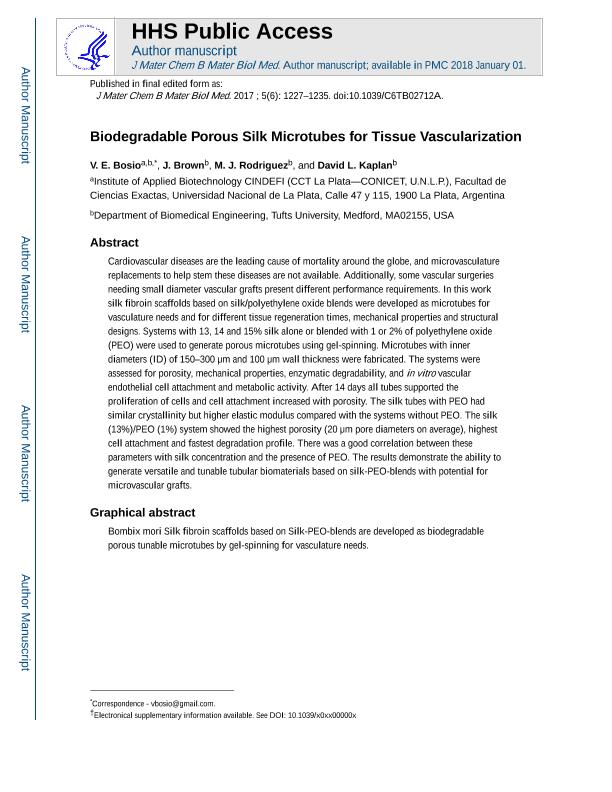Artículo
Biodegradable porous silk microtubes for tissue vascularization
Fecha de publicación:
12/2016
Editorial:
Royal Society of Chemistry
Revista:
Journal of Materials Chemistry B
ISSN:
2050-750X
Idioma:
Inglés
Tipo de recurso:
Artículo publicado
Clasificación temática:
Resumen
Cardiovascular diseases are the leading cause of mortality around the globe, and microvasculature replacements to help stem these diseases are not available. Additionally, some vascular surgeries needing small-diameter vascular grafts present different performance requirements. In this work, silk fibroin scaffolds based on silk/polyethylene oxide blends were developed as microtubes for vasculature needs and for different tissue regeneration times, mechanical properties and structural designs. Systems with 13, 14 and 15% silk alone or blended with 1 or 2% of polyethylene oxide (PEO) were used to generate porous microtubes by gel spinning. Microtubes with inner diameters (IDs) of 150-300 μm and 100 μm wall thicknesses were fabricated. The systems were assessed for porosity, mechanical properties, enzymatic degradability, and in vitro vascular endothelial cell attachment and metabolic activity. After 14 days, all the tubes supported the proliferation of cells and the cell attachment increased with porosity. The silk tubes with PEO had similar crystallinity but a higher elastic modulus compared with the systems without PEO. The silk (13%)/PEO (1%) system showed the highest porosity (20 μm pore diameter on average), the highest cell attachment and the fastest degradation profile. There was a good correlation between these parameters with silk concentration and the presence of PEO. The results demonstrate the ability to generate versatile and tunable tubular biomaterials based on silk-PEO blends with potential for microvascular grafts.
Palabras clave:
Silk
,
Tissue Engineering
,
Vascularization
Archivos asociados
Licencia
Identificadores
Colecciones
Articulos(CINDEFI)
Articulos de CENT.DE INV EN FERMENTACIONES INDUSTRIALES (I)
Articulos de CENT.DE INV EN FERMENTACIONES INDUSTRIALES (I)
Citación
Bosio, Valeria Elizabeth; Brown, J.; Rodriguez, M.J.; Kaplan, D.L.; Biodegradable porous silk microtubes for tissue vascularization; Royal Society of Chemistry; Journal of Materials Chemistry B; 5; 6; 12-2016; 1227-1235
Compartir
Altmétricas




